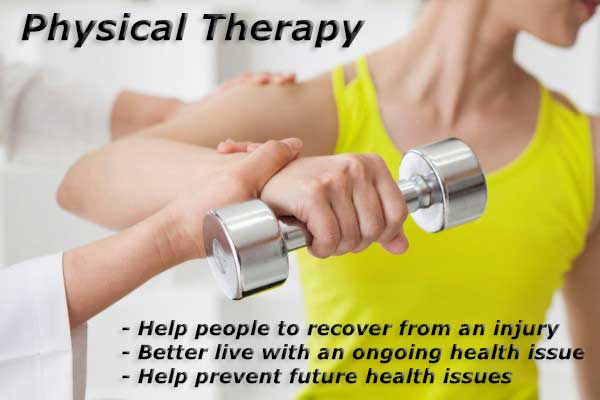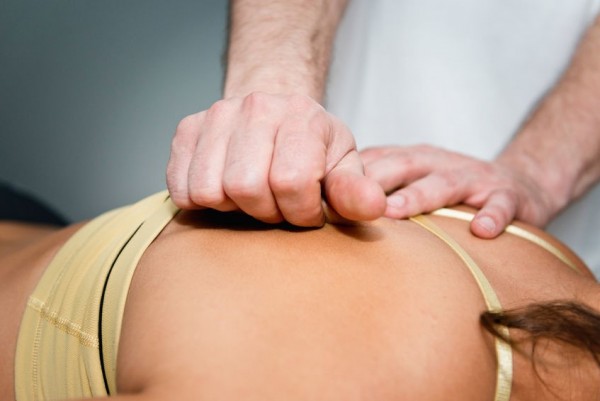
They typically use hands-on treatments and usually teach patients specific exercises to help improve movement and function. In many cases they prevent the need for ongoing prescription medications and expensive surgeries.
American Physical Therapy Association/Who are Physical Therapists?. (2015, November 24). Retrieved from: http://www.apta.org/AboutPTs/
WebMD/What is Physical Therapy/Physical Therapy for Chronic Pain: What to Expect. (2017). Retrieved from: https://www.webmd.com/pain-management/physical-therapy#1
Physical therapists are movement experts who can identify, diagnose, and treat movement problems (Move Forward Physical Therapy Brings Motion to Life). Physical therapists can help people to recover from an injury, better live with their ongoing health issue, or may help prevent future health issues (preventing disabilities). PTs work with individuals to prevent the loss of mobility before it occurs by developing fitness- and wellness-oriented programs for healthier and more active lifestyles (American Physical Therapy Association, 2015). A physical therapist assesses weak areas and creates a plan to strengthen those muscular or skeletal weaknesses. A physical therapist may also prevent the need for ongoing prescription medications or possibly surgeries. 
Physical therapy may strengthen muscles and joints to help a person complete daily activities in a way that doesn’t irritate old injuries, or may prevent the risk of new ones. They may also treat inflammation. Finally, physical therapy can re-educate the central nervous system to be less sensitive to pain signals (Rehab Hub, 2018).
If you have chronic pain and your doctor recommends exercises, a physical therapist can create an exercise and strengthening plan customized to your needs.
Physical therapists will create custom treatment plans for patients based on their health conditions, challenges they face, and goals both short-term and long-term. They should work collaboratively with you toward your goals and empower you to be active in your recovery. Physical therapist will often work collaboratively with other health professionals to create an overall health program for a patient.
Physical Benefits May Include:
- Assistance on how to use a walker or cane, or adjusting to an artificial limb
- Fall prevention
- Balance improvements
- Bladder control improvements

- Circulation improvements
- Everyday functions improvements
- Movement improvements (mobilizing joints and soft tissue)
- Managing a chronic illness more effectively
- Managing age related issues more effectively
- Posture Improvements
- Obtaining a splint or brace
- Reducing need for opioids
- Reducing or even relieving pain
- Recovery from stroke, paralysis, injury, or trauma
- Rehabilitation
- Relieving Pain
- Restoring muscle function
- Strengthening muscles
Move Forward Physical Therapy Brings Motion to Life/Benefits of Physical Therapy. Retrieved from:
https://www.moveforwardpt.com/benefits/default.aspx
American Physical Therapy Association/Who are Physical Therapists?. (2015, November 24). Retrieved from: http://www.apta.org/AboutPTs/
Weber PT, Rebeccah. (2017, September 27). Team Movement for Life/Top 10 Key Benefits of Physical Therapy. Retrieved from: https://www.movementforlife.com/blog/top-5-key-benefits-of-physical-therapy.php
Zavala, Cher. (2018, February 6). Rehab Hub/How Physical Therapy Can Treat Your Chronic Pain. Retrieved from: http://www.rehabpub.com/2018/02/physical-therapy-can-treat-chronic-pain/
WebMD/What is Physical Therapy/Physical Therapy for Chronic Pain: What to Expect. (2017). Retrieved from: https://www.webmd.com/pain-management/physical-therapy#1
Smith BSN MSN CRNP, Lori. (2017, March 8). MEDICAL NEWS TODAY/How can physical therapy help?. Retrieved from: https://www.medicalnewstoday.com/articles/160645.php
Physical therapy has both active and passive therapies. Passive therapies are like massage, where you can just relax and do nothing. Active therapies require your participation like exercises to strengthen the body.
 Craniosacral Therapy: This therapy also called cranial osteopathy and cranial therapy is a manual, non-invasive therapy using gentle hand pressure to manipulate the skeleton and connective tissues, typically the head, skull, and sacrum (the large triangular bone at the base of the spinal column).
Craniosacral Therapy: This therapy also called cranial osteopathy and cranial therapy is a manual, non-invasive therapy using gentle hand pressure to manipulate the skeleton and connective tissues, typically the head, skull, and sacrum (the large triangular bone at the base of the spinal column).
Deep Tissue Massage: This helps with muscle spasms and tension. The therapist uses direct pressure and friction to try to release the tension in your soft tissues (ligaments, tendons, muscles) (spineuniverse).
Dry Needling: Dry Needling is a therapy using thin filiform needles to relieve muscular pain and improve movement. It treats dysfunctions in skeletal muscle, fascia and connective tissues.
Fascial Counterstrain: This is a manual therapy therapy that is just starting to gain in popularity. Almost all painful conditions are reported to have inflammation in the fascia according to recent research. This therapy focuses on the fascia, by relieving tightness in “tender points” in the body by applying pressure to the area that is “pulsing.” This requires special training, because there are over 700 “tender points” in the body, and the therapist has to figure out which ones to treat. It can be used for the very acute traumas (i.e. sports injuries, motor vehicle accidents, ankle sprains, post-surgical, etc.) to the more chronic (i.e. osteoarthritis, fibromyalgia, TMJ pain, headaches, etc.) (ARC Physical Therapy).
Functional Electrical Stimulation: This treatment is often used to restore muscular function after a traumatic injury. By applying a minor but steady electrical stimulus, therapists can cause contractions from muscles that may otherwise remain dormant (GREATIST, 2013).
Graded Motor Imagery: This therapy is about using your own brain to treat pain by using the plasticity and neural connections. The therapy uses techniques such as visualizing movement without actually moving, using mirrors to trick your brain into thinking that you’re moving a weaker or painful body part when you’re actually moving a stronger body part, and using left-right discrimination exercises to recalibrate crucial parts of your brain that help in pain recovery (Rehab Hub). The goals is to improve confidence in your physical strengthen to regain motor control and more effectively respond to pain.
 Hydrotherapy (Hot and Cold Therapies): Hydrotherapy also known as aquatic therapy, uses water for restoring, maintaining, and regulating health. Water is used to alter the intensity of an exercise, and due to the buoyancy of water it is less stressful on a person’s joints and body in general. These may include steam baths, saunas, aquatic exercises, hot/cold compresses, hot/cold showers, and water therapy. Choosing hot vs. cold temperatures is a big part of hydrotherapy. A therapist will often alternative between hot and cold therapy. Both temperatures alter blood flow in the body differently and can help remove waste byproducts to help healing. Physical therapists use all different types of hydrotherapy to help with chronic pain.
Hydrotherapy (Hot and Cold Therapies): Hydrotherapy also known as aquatic therapy, uses water for restoring, maintaining, and regulating health. Water is used to alter the intensity of an exercise, and due to the buoyancy of water it is less stressful on a person’s joints and body in general. These may include steam baths, saunas, aquatic exercises, hot/cold compresses, hot/cold showers, and water therapy. Choosing hot vs. cold temperatures is a big part of hydrotherapy. A therapist will often alternative between hot and cold therapy. Both temperatures alter blood flow in the body differently and can help remove waste byproducts to help healing. Physical therapists use all different types of hydrotherapy to help with chronic pain.
Joint Mobilization: This is a passive therapy where the physical therapist will move joints in the body in certain directions in order to reduce pain and improve movement. There is a gliding movement that occurs when joints move, the therapist increases this gliding motion.
Kinesiology Taping: This therapy involves applying tape to the skin. The taps is made of a flexible fabric that will stretch and pull as you move. It is used for muscle inhibition, muscle facilitation, pain relief, and improving bruising and swelling.
Low-Impact Aerobics Training: These exercises consist of increasing the heart rate without tensing up joints. This could be an exercise on a stationary bike or walking fast to warm up muscles before doing strengthening exercises.
Low-Level Laser: This therapy is great for muscular or connective tissues injuries. It focuses specific wavelengths of light below the skin to stimulate healing.
 Myofascial Release: Also known as myofascial therapy, this is a type of massage/stretch done to relieve soft tissue restrictions that are sensitive or tight causing pain. Pain typically comes from specific points within your myofascial tissues called “trigger points.” Myofascial release relieves tension and tightness in these trigger points restoring motion and function.
Myofascial Release: Also known as myofascial therapy, this is a type of massage/stretch done to relieve soft tissue restrictions that are sensitive or tight causing pain. Pain typically comes from specific points within your myofascial tissues called “trigger points.” Myofascial release relieves tension and tightness in these trigger points restoring motion and function.
Pain Relief Exercises: Certain movements focusing on the areas you have pain will help to improve flexibility and strengthen muscles.
Sensory Re-Education: Sometimes the body can still feel pain even after it has been healed. This is due to the nervous system being too overwhelmed from constant pain. Sensory re-education uses light stimuli on both problem and non-problem areas, and the brain compares the sensations of both areas to lessen the sensitivity in the painful area.
 Strengthening Exercises: This is one of the most common therapies when receiving physical therapy. Strengthening exercises may be done on machines, utilize resistance bands, weights, or using your own body’s weight with lunges, squats, planks, or pushups. The exercises you do will be customized to your specific health issue.
Strengthening Exercises: This is one of the most common therapies when receiving physical therapy. Strengthening exercises may be done on machines, utilize resistance bands, weights, or using your own body’s weight with lunges, squats, planks, or pushups. The exercises you do will be customized to your specific health issue.
Stretching: You will learn gentle stretches that will help warm up muscles or improve flexibility.
TENS (transcutaneous electrical nerve stimulation): A TENS machine stimulates injured areas through attaching electrodes, that are attached to the skin, and administering low-voltage electrical currents. These electrodes will intercept pain messages to the brain from nerves in the area reducing pain. TENS will also increase endorphins, your body’s natural pain killers, and lessen muscle spasms.
Traction: This helps to improve low back pain and neck pain, improving movement in the spine. This involves being strapped into a machine where a mechanical force is applied. It works by separating joints, vertebrae and disc spaces in the low back and neck. This reduces pressure on spinal nerves and lessens compression on disc cartilage.
Ultrasound: This therapy sends sound waves deep into muscle tissues and tendons producing a light heat that improves healing and blood circulation. It can reduce cramping, swelling, stiffness, muscle spasms, and pain.
Duvall, Jeremey. (2013, January 10). GREATIST/The 8 Best Physical Therapy Methods Explained. Retrieved from: https://greatist.com/fitness/physical-therapy-best-methods-explained
Zavala, Cher. (2018, February 6). Rehab Hub/How Physical Therapy Can Treat Your Chronic Pain. Retrieved from: http://www.rehabpub.com/2018/02/physical-therapy-can-treat-chronic-pain/
Sears PT, Brett. (2017, July 30). very well health/How Long Should You Attend Physical Therapy/Physical Therapy Treatments and Modalities List. Retrieved from: https://www.verywellhealth.com/how-long-should-you-attend-physical-therapy-3975127
ARC Physical Therapy/Fascial Counterstrain. Retrieved from: http://arcphysicaltherapy.com/services/fascial-counterstrain/
WebMD/What is Physical Therapy/Physical Therapy for Chronic Pain: What to Expect. (2017). Retrieved from: https://www.webmd.com/pain-management/physical-therapy#1
Richeimer MD., Steven. spineuniverse/Physical Therapy for Chronic Pain. Retrieved from:
https://www.spineuniverse.com/conditions/chronic-pain/physical-therapy-chronic-pain
A physical therapist should create a custom plan for you, based on your body and your health condition. There are many different areas to specialize in for physical therapy so it is important to choose the right type of physical therapist.
Physical therapy can also in many situations prevent the need for surgery and taking drugs on a regular basis. So it is a safer option for many people. You may be sore after doing physical therapy, but that is normal when stretching or receiving deep tissue massages. Physical therapy even though it is usually safe, it can be very challenging because you are working a part of your body that is injured or has chronic pain. Physical therapists often help improve safety, because they teach people in pain how to complete daily tasks safer, and do exercises that will cause less pain and help improve pain levels.
Sears PT, Brett. (2017, July 30). very well health/How Long Should You Attend Physical Therapy/Physical Therapy Treatments and Modalities List. Retrieved from: https://www.verywellhealth.com/how-long-should-you-attend-physical-therapy-3975127
WebMD/What is Physical Therapy/Physical Therapy for Chronic Pain: What to Expect. (2017). Retrieved from: https://www.webmd.com/pain-management/physical-therapy#1
Weber PT, Rebeccah. (2017, September 27). Team Movement for Life/Top 10 Key Benefits of Physical Therapy. Retrieved from: https://www.movementforlife.com/blog/top-5-key-benefits-of-physical-therapy.php
They also help people regain original capabilities, avoid dependence on pain medication, and manage heart and lung disease.
Health Conditions Physical Therapists Help with Include
- Autoimmune Disorders (Arthritis and Rheumatoid Arthritis)
- Burns
- Cardiopulmonary Conditions (chronic obstructive pulmonary disease, Cystic fibrosis, and post myocardial infarction)
- Carpal Tunnel Syndrome
 Childhood Obesity
Childhood Obesity- Concussions
- Diabetes
- Down Syndrome
- Headaches
- Injuries (recreational, sports or work related)
- Joint Dysfunction
- Musculoskeletal Dysfunction (back pain, rotator cuff tears, and TMJ)
- Neonatal Care
- Neurological Conditions (Guillain-Barre Syndrome, Lou Gehrig’s Disease, Multiple Sclerosis, Parkinson’s Disease, Reflex Sympathetic Dystrophy, Spinal Cord Injuries, Stroke, Trigeminal Neuralgia)
- Pediatric Conditions (development delays, Cerebral Palsy, and Muscular Dystrophy)
- Post-operative orthopedic patients
- Surgery Recovery
- Traumatic Brain Injuries, and Vestibular dysfunction.
- Trigger Finger
- Vascular Conditions
- Vertigo
- Women’s Health Conditions (lymphedema, pelvic floor dysfunction, and urinary incontinence)
Athletico. (2013, October 1). ATHLETICO PHYSICAL THERAPY/6 Conditions You May Not Realize Physical Therapists Treat. Retrieved from: http://www.athletico.com/2013/10/01/6-conditions-know-physical-therapists-treated/
Hansen Family Hospital/What conditions do physical therapists treat?. Retrieved from:
http://www.hansenfamilyhospital.com/what-conditions-do-physical-therapists-treat
Physical Therapy Web/Conditions, Injuries, Diseases Treated by Physical Therapists. Retrieved from:
https://physicaltherapyweb.com/conditions-injuries-diseases-treated-physical-therapists/
Weber PT, Rebeccah. (2017, September 27). Team Movement for Life/Top 10 Key Benefits of Physical Therapy. Retrieved from: https://www.movementforlife.com/blog/top-5-key-benefits-of-physical-therapy.php
WebMD/What is Physical Therapy/Physical Therapy for Chronic Pain: What to Expect. (2017). Retrieved from: https://www.webmd.com/pain-management/physical-therapy#1
Smith BSN MSN CRNP, Lori. (2017, March 8). MEDICAL NEWS TODAY/How can physical therapy help?. Retrieved from: https://www.medicalnewstoday.com/articles/160645.php
 There are many programs out there now offering a Doctor of Physical Therapy (DPT) degree. Currently, 199 colleges and universities nationwide support 212 accredited professional physical therapist education programs; 96% now offer the DPT and the remaining programs are planning to convert (American Physical Therapy Association, 2015). Once students receive their degree they must pass a state-administrated national exam. From there some physical therapists may have additional requirements based on state regulations or physical therapy practice acts for their location.
There are many programs out there now offering a Doctor of Physical Therapy (DPT) degree. Currently, 199 colleges and universities nationwide support 212 accredited professional physical therapist education programs; 96% now offer the DPT and the remaining programs are planning to convert (American Physical Therapy Association, 2015). Once students receive their degree they must pass a state-administrated national exam. From there some physical therapists may have additional requirements based on state regulations or physical therapy practice acts for their location.
During several years of training, physical therapists study areas such as biology, anatomy, cellular histology, physiology, exercise physiology, biomechanics, kinesiology, neuroscience, pharmacology, pathology, behavioral sciences, cardiovascular and pulmonary, endocrine and metabolic, and musculoskeletal studies (MEDICAL NEWS TODAY, 2017).
American Physical Therapy Association/Who are Physical Therapists?. (2015, November 24). Retrieved from: http://www.apta.org/AboutPTs/
Smith BSN MSN CRNP, Lori. (2017, March 8). MEDICAL NEWS TODAY/How can physical therapy help?. Retrieved from: https://www.medicalnewstoday.com/articles/160645.php
Physical Therapy is Centuries Old
Physical therapy, common to many other alternative treatments, was developed by Hippocrates. It is recorded that Hippocrates, the father of modern medicine, introduced manual manipulation for pain relief in 460 BC. In that time, it was mostly simple massage, there wasn’t all the specialized therapies we have now. One physical therapy treatment that was practiced in Greece in 460 BC is Hydrotherapy, water treatment. Around the same time, ancient writings show China, Egypt, and Persia also used some form of physical therapy.
 Physical Therapy’s Growth in the United States
Physical Therapy’s Growth in the United States
Physical therapy practice in the United States evolved around two major historical events: the poliomyelitis epidemics of the 1800s through the 1950s and the effects of the ravages of several wars (Journal of Physical Therapy Education, 2003). To read more about how physical therapy evolved during the historical wars view the Journal of Physical Therapy Association.
Mary McMillan and Marguerite Sanderson were two of the first people to take part in training of “reconstruction aides” which helped wounded soldiers in World War I. In 1921, Mary McMillian established the American Women’s Physical Therapeutic Association, which is still in existence today, now called the American Physical Therapy Association (APTA). Due to her contributions, Mary became known as the “Mother of Physical Therapy.” Another important event in the year 1921, was a significant research paper that was published in the PT Review in the U.S. In the last 1950s, yet another significant change in the world of physical therapy was made when physical therapists started treating patients outside of hospitals and establishing their own practices.
Marilyn PT PhD CSCS FAPTA, Moffat. (2003). Journal of Physical Therapy Education. Retrieved from:
Physiotherapy-treatment.com/History of Physical Therapy. (2009, April 18). Retrieved from:
https://www.physiotherapy-treatment.com/history-of-physical-therapy.html
Insurance for Physical Therapy
 Many physical therapists are covered under insurance at least in the United States. Therefore, your first step in finding a physical therapist may be getting a referral from your doctor, and then checking with your health insurance company to see if there are some therapists covered. It is not a requirement to have a referral from your doctor in order to take part in physical therapy. However, it may be a requirement based on your insurance policy. You can also look for natural health clinics that have physical therapists or search for private practices.
Many physical therapists are covered under insurance at least in the United States. Therefore, your first step in finding a physical therapist may be getting a referral from your doctor, and then checking with your health insurance company to see if there are some therapists covered. It is not a requirement to have a referral from your doctor in order to take part in physical therapy. However, it may be a requirement based on your insurance policy. You can also look for natural health clinics that have physical therapists or search for private practices.
Another place to search for a physical therapist in the United States is the American Physical Therapy Association’s directory.
Specialized Fields for Physical Therapists
It is important to find a physical therapist that specializes in the correct field. Physical therapists may specialize in:
- Cardiovascular and Pulmonary health (improve cardiopulmonary conditions and affects from surgical procedures)
- Decongestive Therapy (help with draining fluid in patients with conditions like lymphedema)
- Geriatric (help older patients with arthritis, osteoporosis, Alzheimer’s disease, hip or joint replacement, incontinence, or balance)
 Neurology (help people with Alzheimer’s disease, brain injury, cerebral palsy, multiple sclerosis, Parkinson’s disease, spinal cord injury, or stroke)
Neurology (help people with Alzheimer’s disease, brain injury, cerebral palsy, multiple sclerosis, Parkinson’s disease, spinal cord injury, or stroke)- Orthopedic (focus on musculoskeletal injuries of muscles, tendons, fascia, bones, and ligaments such as fractures, sprains, tendonitis, bursitis, and treating orthopedic surgery)
- Pediatrics (help infants, children, adolescents, including development delays, cerebral palsy, spina bifida, torticollis, and other musculoskeletal conditions)
- Pelvic Floor Rehabilitation (treat urinary or fecal incontinence and pelvic pain for both men and women usually resulting from an injury or surgery)
- Sports Physical Therapy
- Vestibular Therapy (balance problems from inner ear conditions)
- Women’s Health
- Wound Care Therapy (heal wounds by improving circulation so wounds receive enough oxygen and blood)
Move Forward Physical Therapy Brings Motion to Life/Benefits of Physical Therapy. Retrieved from:
https://www.moveforwardpt.com/benefits/default.aspx
Smith BSN MSN CRNP, Lori. (2017, March 8). MEDICAL NEWS TODAY/How can physical therapy help?. Retrieved from: https://www.medicalnewstoday.com/articles/160645.php
WebMD/What is Physical Therapy/Physical Therapy for Chronic Pain: What to Expect. (2017). Retrieved from: https://www.webmd.com/pain-management/physical-therapy#1
Then, you will receive a diagnosis and a customized treatment plan based on long term and short terms goals that you figured out with your therapist. The therapist may start off with treatments that require no participation on your part like massage, and then slowly move into treatments that require your active participation. Physical therapists will usually provide exercises or stretches for you to do in the comfort of your own home, as well.
 A person should continue to go to physical therapy until they reach their health goals set by them and their therapist. If goals are not being met within a reasonable time frame, it may be necessary to reestablish goals or discontinue therapy altogether. It usually takes 6 to 8 weeks for soft tissue to heal, but therapy could take longer. It all depends on the person and their specific health issue. A good physical therapist knows their limitations, and will know when they can’t help someone, or can no longer help a person.
A person should continue to go to physical therapy until they reach their health goals set by them and their therapist. If goals are not being met within a reasonable time frame, it may be necessary to reestablish goals or discontinue therapy altogether. It usually takes 6 to 8 weeks for soft tissue to heal, but therapy could take longer. It all depends on the person and their specific health issue. A good physical therapist knows their limitations, and will know when they can’t help someone, or can no longer help a person.
Sears PT, Brett. (2017, July 30). very well health/How Long Should You Attend Physical Therapy/Physical Therapy Treatments and Modalities List. Retrieved from: https://www.verywellhealth.com/how-long-should-you-attend-physical-therapy-3975127
WebMD/What is Physical Therapy/Physical Therapy for Chronic Pain: What to Expect. (2017). Retrieved from: https://www.webmd.com/pain-management/physical-therapy#1
Smith BSN MSN CRNP, Lori. (2017, March 8). MEDICAL NEWS TODAY/How can physical therapy help?. Retrieved from: https://www.medicalnewstoday.com/articles/160645.php
Sears PT, Brett. (2017, July 30). very well health/How Long Should You Attend Physical Therapy/Physical Therapy Treatments and Modalities List. Retrieved from: https://www.verywellhealth.com/how-long-should-you-attend-physical-therapy-3975127
Zavala, Cher. (2018, February 6). Rehab Hub/How Physical Therapy Can Treat Your Chronic Pain. Retrieved from: http://www.rehabpub.com/2018/02/physical-therapy-can-treat-chronic-pain/
WebMD/What is Physical Therapy/Physical Therapy for Chronic Pain: What to Expect. (2017). Retrieved from: https://www.webmd.com/pain-management/physical-therapy#1
Richeimer MD., Steven. spineuniverse/Physical Therapy for Chronic Pain. Retrieved from:
https://www.spineuniverse.com/conditions/chronic-pain/physical-therapy-chronic-pain
American Physical Therapy Association/Who are Physical Therapists?. (2015, November 24). Retrieved from: http://www.apta.org/AboutPTs/
Smith BSN MSN CRNP, Lori. (2017, March 8). MEDICAL NEWS TODAY/How can physical therapy help?. Retrieved from:
https://www.medicalnewstoday.com/articles/160645.php
Marilyn PT PhD CSCS FAPTA, Moffat. (2003). Journal of Physical Therapy Education. Retrieved from:
Physiotherapy-treatment.com/History of Physical Therapy. (2009, April 18). Retrieved from:
https://www.physiotherapy-treatment.com/history-of-physical-therapy.html
Weber PT, Rebeccah. (2017, September 27). Team Movement for Life/Top 10 Key Benefits of Physical Therapy. Retrieved from: https://www.movementforlife.com/blog/top-5-key-benefits-of-physical-therapy.php
Move Forward Physical Therapy Brings Motion to Life/Benefits of Physical Therapy. Retrieved from:
https://www.moveforwardpt.com/benefits/default.aspx
ARC Physical Therapy/Fascial Counterstrain. Retrieved from: http://arcphysicaltherapy.com/services/fascial-counterstrain/
Duvall, Jeremey. (2013, January 10). GREATIST/The 8 Best Physical Therapy Methods Explained. Retrieved from: https://greatist.com/fitness/physical-therapy-best-methods-explained
Athletico. (2013, October 1). ATHLETICO PHYSICAL THERAPY/6 Conditions You May Not Realize Physical Therapists Treat. Retrieved from: http://www.athletico.com/2013/10/01/6-conditions-know-physical-therapists-treated/
Hansen Family Hospital/What conditions do physical therapists treat?. Retrieved from:
http://www.hansenfamilyhospital.com/what-conditions-do-physical-therapists-treat
Physical Therapy Web/Conditions, Injuries, Diseases Treated by Physical Therapists. Retrieved from:
https://physicaltherapyweb.com/conditions-injuries-diseases-treated-physical-therapists/
